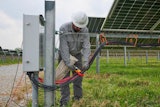Results from a continuing study by New York's Monroe County Water Authority (MCWA) indicate that applying anticorrosion, low-friction coatings can restore pump efficiency to the manufacturer's new-pump specifications.
In addition to Monroe County, the Rochester-based MCWA supplies drinking water to customers in portions of four other counties, serving a total of more than half a million people. Demand averages 50-60 million gallons per day. In normal operation, the authority's pumps experience internal corrosion and rust buildup (tuberculation). In the study, which dealt with smaller horizontal split-case pumps, those that were cleaned and coated showed significant efficiency improvements.
"We just couldn't believe it," says MCWA water system analyst Paul Maier. "The results we got from lining pump casings with ceramic-filled epoxy coatings are encouraging news for water suppliers all across the country. Depending on pump size and usage, even a 2% increase in efficiency can pay back the cost of the coating and the labor to apply it in less than one year. In addition to lowering electric bills and/or increasing pump performance, these coatings may extend the service life of pumps. Durability, of course, will be a factor in the long run -- some of these coatings will last longer than others."
The MCWA conducted the tests during 2004 and 2005 on five relatively small (less than 100 hp) single-stage, double-suction, cast-iron, horizontal split-case pumps.
Coatings Make a Difference
Some of the pilot study's most dramatic results came from the MCWA's Moseley Road booster pump, a 75-hp Goulds Model 3405M with 5 in. suction, 8 in. discharge, and a 13½ in. diameter impeller. The MCWA maintenance department first dismantled and rebuilt the pump, installing new bearings, sleeves, and wear rings. MCWA contracted with a local shop to sandblast the pump casing to remove all interior rust and achieve a white-metal finish (SSPC-SP5).
Next, two Devcon products, chosen by the MCWA for their surface-friction coefficients, shear strength, cavitation resistance, immersion characteristics, and overall corrosion-prevention properties, were applied to the freshly prepared casing. Devcon Ceramic Repair Putty™ was used to fill voids and create a uniform surface profile. Then two coats of Devcon Brushable Ceramic, which is NSF-certified for potable water applications, were applied. (Photo shows interior of one side of a pump casing; surfaces that come in contact with water have been coated with a Devcon coating to reduce friction.)
Applied by trowel, Devcon Ceramic Repair Putty is a durable alumina-filled epoxy compound that repairs and protects worn metal by filling voids and curing to a hard, durable surface. Devcon Brushable Ceramic is a precision-repair epoxy coating engineered to form a smooth, long-lasting protective barrier against wear, abrasion, corrosion, cavitation, and chemical attack. Easily applied with a roller or short-bristle brush, it seals and protects new surfaces or reconditions old ones, improving the performance and longevity of pump casings, impellers, valves, tanks, and other critical equipment.
The flow, head, and efficiency of the Devcon-coated pump were all restored to the manufacturer's specifications for a new pump. In other words, after cleaning and coating, the pump was as good hydraulically as when it was new. When the MCWA tested the efficiency of the pump approximately 6 months after the initial testing, the pump showed no measurable decline in performance.
MCWA tested other brands of coatings on the four other pumps, but variations in the size and condition of the pumps rule out definitive comparison between coatings with respect to their ability to increase pump performance. All in all, the Moseley Road pump lined with Devcon coatings showed significant efficiency gains. Its efficiency increased by approximately 18% (from about 64-82%) as a result of mechanical refurbishment and the cleaning and coating efforts.
Based on prior experience, the MCWA estimates that at least half of this total increase in pump efficiency was attributable to the cleaning and coating efforts, while the other half was due to mechanical refurbishment.
Quantifying Results
For just 2 of the 5 pumps in the pilot study, the MCWA crew replaced the bearings, sleeves, and wear rings, but reassembled the pump without removing the interior rust buildup. Before sandblasting and coating, the crew then monitored the performance (suction, discharge, flow, and power consumption) of the pumps to compare energy efficiency with pre-rebuild readings and to establish a post-rebuilding/pre-coating baseline.
This is the only way to quantify how much of a pump's total performance improvement is due to rebuilding and how much is due to coating. After several weeks, the two pumps were again disassembled, this time for sandblasting and coating. While this type of baseline was not established for the Moseley Road pump and two others, one of the two pumps for which it was established -- Woodcliff Station -- showed an overall efficiency increase of 25% (11% from rebuilding and 14% from sandblasting and coating).
Forthcoming tests on the MCWA's larger pumps promise to be more scientific -- they will all be done with a post-rebuilding/pre-coating baseline.
Based on the encouraging results, the MCWA and the New York State Energy and Research Development Authority (NYSERDA) are jointly funding a test project to coat additional pumps and collect data over the next three years -- part of the state's efforts to encourage the adoption of emerging or underutilized energy-reducing products and technologies.
MCWA engineers and maintenance technicians are now planning the next phase of the testing, which will monitor the effects of several coatings on the efficiency of larger pumps (1,500-1,750 hp) that use far more electricity.
MCWA engineers believe that reducing friction is the key factor in increasing pump efficiency. Without a good protective coating, over time rust and corrosion create such a rough surface on the pump's interior casing that the pump has to work harder (decreasing pump efficiency and increasing energy consumption) to overcome the efficiency losses due to friction with the rough interior surface.
Looking Ahead
Thanks to power monitors purchased and installed under an earlier load-shedding grant from NYSERDA, the MCWA is able to measure energy usage (in kilowatts) for individual pumps -- in real time. Prior to the installation of the power monitors, MCWA engineers thought that the kilowatt-demand portion of the electric bill for many pump stations was higher than it should have been, and they suspected that part of the reason was poor pump efficiency. But, without the monitor, the MCWA was unable to accurately calculate a pump's efficiency in the field.
"We never thought that roughness of internal pump surfaces could be costing us so much money, so we couldn't justify the material and maintenance expense of cleaning and coating pump interiors," notes Maier. "And, there was very little information available documenting the effects of internal corrosion on a pump's overall efficiency. However, once the monitors were installed, our engineers began measuring the actual field efficiency of a pump and comparing it with the manufacturer's specified efficiency. After running tests on pumps in our distribution system, our engineers were shocked to find that many were operating 15-25% below the manufacturer's specifications.
"Obviously, the more you run a pump, the more electricity it uses, and the more you're going to benefit from increases in efficiency," Maier adds.
The pumps selected for the pilot study were chosen because they needed mechanical work, not because they were large energy users. MCWA engineers didn't want to start with the larger, heavier pumps because of the extra labor involved. However, considering the significant improvement in pump efficiency achieved on smaller pumps in the pilot study, MCWA engineers are now excited that they may achieve similar improvements with their larger pumps, where most of their energy dollars are spent.
It will be several years before the MCWA has figures on the larger pumps (greater than 1,000 hp), but the Authority is encouraging other municipalities to perform similar experiments with interior pump coatings. After extensive research, the MCWA has concluded that pump manufacturers and users have largely ignored corrosion-caused decreases in pump performance over time. Maier hopes that other water suppliers who do not have the resources to conduct their own testing will rely on MCWA results and begin coating their pumps.
Based on test results thus far, the MCWA is convinced that cleaning and coating pump interiors saves money. Since the horizontal split-case pump is one of the most commonly used in water distribution systems, MCWA results should be indicative of the potential for savings at other water authorities. The beauty of pump cleaning and coating is that it doesn't require sophisticated tools, equipment, expertise, or training.
Maintenance employees in even the smallest municipalities have the skills necessary to pull these pumps apart, clean, and coat them. For municipalities without sandblasting equipment, the local auto body shop probably has sufficient capability. Coating pumps is not hard to do, and based on MCWA's results, it appears to be well worth the effort.



















